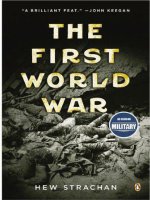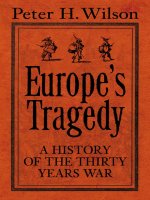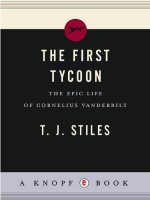Robert leckie challenge for the pacific gua war (v5 0)
Bạn đang xem bản rút gọn của tài liệu. Xem và tải ngay bản đầy đủ của tài liệu tại đây (2.48 MB, 300 trang )
Praise for
CHALLENGE FOR THE PACIFIC
“[Leckie] has succeeded in compressing numerous tales into a readable story, but his greatest contribution is a unique
feeling for combat.… His marines are living, brawling, obscene, blasphemous—and utterly believable. He has caught their
gallows humor, their cockiness and their savagery in the business of battle.”
—JOHN TOLAND, The New York Times Book Review
“A stirring story of America’s survival in its grimmest hour … as readable and gripping as a novel.”
—The Patriot Ledger (Massachusetts)
“Here is a book to wrench the heart. It is a driving, relentless narrative that summons up all of the hideous color and
clamor of battle. But, more than that, it is a timely evocation of what a nation must do in wars to preserve its freedom.…
[This] book is a splendid weld of the strategies, views and experiences of soldiers, sailors and airmen.”
“Leckie is a brilliant war writer.”
—Newark News
—New Orleans Times-Picayune
“[A] true winner … Excitement, action, fast narrative pace, and a deep respect for the rudiments of genuine patriotism
mark the story.… [Leckie] presents the Allies and the Japanese as separate people, giving them the stature of human
beings involved in desperate battle.”
—Nashville Banner
“Despite its scope, the story is told in individual terms—Japanese and American. Characters are very much alive on the
printed page. Challenge for the Pacific is fast-paced and informative.”
—Navy Times
“An exceedingly good account of a feat of arms which remains unsurpassed … enthralling.”
—The Times Literary Supplement
“[An] epic tale ably told … To those who were there this book will bring back vivid memories.… To those who were not
there this book should bring some small realization of what it was like.”
—El Paso Times
“Detailed and dramatic … In these pages one can feel the frustration, despair and confusion experienced by both sides in
the savage see-saw struggle.”
—Tulsa World
“Leckie puts esh on the bones of history.… The book has the ring of authenticity.… It is intensely dramatic, vivid, broad,
and yet intimate in detail, deeply moving in its portrayal of the human side of war. In the best sense, it is history made
alive.”
“A vivid portrayal … worthy of attention.”
—Pasadena Star-News
—Buffalo Courier-Express
“Challenge for the Paci c is more than the battle of Guadalcanal. It is the living and dying of Americans and Japanese.…
[Leckie] knows how a ground-pounding Marine thinks, talks and reacts.”
—Leatherneck magazine
“Leckie describes this outstanding American combined operation from an intensely personal yet well-documented angle.”
—The Daily Telegraph
2010 Bantam Books Trade Paperback Edition
Copyright © 1965 by Robert Leckie
All rights reserved.
Published in the United States by Bantam Books, an imprint of The Random House Publishing Group, a division of
Random House, Inc., New York.
BANTAM BOOKS and the rooster colophon are registered trademarks of Random House, Inc.
Originally published in hardcover and in slightly different form in the United States by Doubleday, a division of Random
House, Inc., in 1965.
Grateful acknowledgment is made for permission to include the following copyrighted material in this book:
Excerpts from A Coastwatcher’s Diary by Martin Clemens. Reprinted by permission of the author.
Excerpts from The Battle for Guadalcanal by Brigadier General Samuel B. Griffith II, copyright © 1963 by Samuel B.
Griffith II. Published by J. B. Lippencott Company.
Reprinted by permission of the publisher.
Excerpts from Strong Men Armed by Robert Leckie, copyright © 1962 by Robert Leckie; Helmet for My Pillow by Robert
Leckie, copyright © 1957 by Robert Hugh Leckie. Reprinted by permission of Random House, Inc., and the author.
Excerpts from Once a Marine: The Memoirs of a General A. A. Vandegrift, U.S.M.C., as told to Robert B. Asprey, copyright
© 1964 by A. A. Vandegrift and R. B. Asprey. Reprinted by permission of W. W. Norton & Company, Inc.
Excerpts from Japanese Destroyer Captain by Commander Tameichi Hara, with Fred Saito and Roger Pineau, copyright ©
1961 by Captain Tameichi Hara, Fred Saito, and Roger Pineau. Reprinted by permission of Ballantine Books, Inc.
eISBN: 978-0-553-90824-4
Maps by Liam Dunne
www.bantamdell.com
v3.1
To Bud Conley, Lew Juergens, and Bill Smith,
my buddies on Guadalcanal
PREFACE
—the twentieth anniversary of the landings at Guadalcanal—men of the
First Marine Division Association received a message from Sergeant Major Vouza of the
British Solomon Islands Police. Vouza said: “Tell them I love them all. Me old man now,
and me no look good no more. But me never forget.”
Neither would anyone else who had been on Guadalcanal, not the Japanese who
tortured Vouza, and from whom this proud and erce Solomon Islander exacted a
fearsome vengeance, not the Americans who ultimately conquered. For Guadalcanal, as
the historian Samuel Eliot Morison has said, is not a name but an emotion. It is a word
evocative, even, of sense perception; of the putrescent reek of the jungle, the sharp ache
of hunger or the pulpy feel of waterlogged esh, as well as of all those clanging,
bellowing, stuttering battles—land, sea, and air—which were fought, night and day, to
determine whether America or Japan would possess a ramshackle air eld set in the
middle of 2500 square miles of malarial wilderness.
More important, historically, Guadalcanal was the place at which the tide in the
Paci c War turned against Japan. Although this distinction has often been conferred
upon Midway, the fact remains that the naval air battles fought at Midway did not turn
the tide, but rather gave the rst check to Japanese expansion while restoring, through
the loss of four big Japanese aircraft carriers as against only one American, parity in
carrier power.
After Midway the Japanese were still on the o ensive. They thought that way and
they acted that way. “After Coral Sea and Midway, I still had hope,” said Captain
Toshikazu Ohmae, operations o cer for the Japanese Eighth Fleet, “but after
Guadalcanal I felt that we could not win.” Rear Admiral Raizo Tanaka, commander of
the Guadalcanal Reinforcement Force, goes even further, declaring: “There is no
question that Japan’s doom was sealed with the closing of the struggle for Guadalcanal.”
Captain Tameichi Hara, a destroyer commander who fought under Tanaka at both
Midway and Guadalcanal, shares his chief’s opinion, writing: “What really spelled the
downfall of the Imperial Navy, in my estimation, was the series of strategic and tactical
blunders by (Admiral) Yamamoto after Midway, the Operations that started with the
American landing at Guadalcanal in early August, 1942.” And from the Japanese Army,
as represented by Major General Kiyotake Kawaguchi, commander of Japan’s rst
major attempt to recapture the island, comes this categorical statement: “Guadalcanal is
no longer merely a name of an island in Japanese military history. It is the name of the
graveyard of the Japanese Army.”
Guadalcanal was also the graveyard for Japan’s air force. Upwards of 800 aircraft,
with 2362 of her nest pilots and crewmen, were lost there. Perhaps even more
important, the habit of victory deserted the heretofore invincible Japanese pilots there,
ON AUGUST 7, 1962
and before the battle was over Japanese carrier power ceased to be a factor in the
Paci c until, nearly two years later, the invasion of Saipan lured it to its e ective
destruction. Japanese naval losses were also high. Even though Japan’s loss of 24
warships totaling 134,389 tons was hardly greater than the American loss of 24
warships totaling 126,240 tons, Japan could not come close to matching the American
replacement capacity. Finally, the total American dead was, at the utmost, only about
one tenth of the Japanese probable total of fifty thousand men.
However, neither comparative statistics nor the number of men and arms engaged
can measure a battle’s importance in history. Only a few hundred fell when Joan of Arc
raised the siege of Orléans and changed the course of events in the west, while
Marathon, Valmy, Saratoga and Waterloo—to name a few other decisive battles—would
not, in combined casualties, equal the number of those whose blood stained one of
Genghis Khan’s forgotten battle elds. A battle is only great because after it has been
fought things are never the same. The war has been changed in its direction, its mood,
its attitudes, its men, and sometimes its very tactics. Finally, in changing a war, a great
battle alters the course of world events.
This condition and its corollaries are ful lled by Guadalcanal. After Guadalcanal the
Paci c War that had been moving south toward Australasia-Fijis-Samoa turned north
toward Japan, and the United States, having been starved for victory, never again
tasted defeat. More simply, after Guadalcanal the Americans were on the o ensive and
the Japanese were on the defensive.
It was at Guadalcanal that such myths as the invincibility of the Japanese soldier or
Zero ghter-plane were destroyed, that such devices as radar-controlled naval gun re
were introduced, and that such reputations as those of Chuichi Nagumo, the hero of
Pearl Harbor, or the idolized Isoroku Yamamoto were either ruined or tarnished while
those of such Americans as Halsey, Kinkaid, and Richmond Kelly Turner among the
admirals, Alexander Patch and Lightning Joe Collins among the Army generals, and
Archer Vandegrift and Roy Geiger among the Marines, were being made. From
Guadalcanal came the tactics—land, sea, and air—which were to become American
battle doctrine throughout World War II, and out of this struggle emerged the seasoned
young leaders who were to command the ships and regiments and squadrons which
were to strike the Axis enemy everywhere.
Guadalcanal wrecked Japan’s grand strategy. Imperial General Headquarters had
deliberately hurled the surprise attack at Pearl Harbor to prevent the United States Navy
from interfering with the Japanese timetable of conquest in the Paci c. By the time
America had recovered from Pearl Harbor, it was believed, Japan would have built a
chain of impregnable island forts around her stolen empire.
America, tiring of a costly and bloody war, would then be willing to negotiate a peace
favorable to Japan. But Guadalcanal shattered this dream. There, barely a year after
Pearl Harbor, the Americans stood in triumph with their faces turned toward Japan.
And once it was clear that Guadalcanal was lost, the sober heads at Imperial General
Headquarters knew that all was lost. The countries of Southeast Asia, the lush, rich
islands of the Southern Seas—all of these “lands of everlasting summer”—were to be
taken away from them.
After Guadalcanal, as the Japanese knew in their despair, as the Americans realized
with rising jubilation, the Pacific War could never be the same.
ROBERT LECKIE
Mountain Lakes, New Jersey
September 10, 1964
CONTENTS
COVER
PRAISE FOR CHALLENGE FOR THE PACIFIC
TITLE PAGE
COPYRIGHT
DEDICATION
PREFACE
LIST OF MAPS
PART ONE: THE CHALLENGE
CHAPTER ONE
CHAPTER TWO
CHAPTER THREE
CHAPTER FOUR
CHAPTER FIVE
PART TWO: ALONE
CHAPTER SIX
CHAPTER SEVEN
CHAPTER EIGHT
CHAPTER NINE
CHAPTER TEN
CHAPTER ELEVEN
CHAPTER TWELVE
PART THREE: AT BAY
CHAPTER THIRTEEN
CHAPTER FOURTEEN
CHAPTER FIFTEEN
CHAPTER SIXTEEN
PART FOUR: CRISIS
CHAPTER SEVENTEEN
CHAPTER EIGHTEEN
CHAPTER NINETEEN
CHAPTER TWENTY
CHAPTER TWENTY-ONE
CHAPTER TWENTY-TWO
CHAPTER TWENTY-THREE
CHAPTER TWENTY-FOUR
PART FIVE: CRUX
CHAPTER TWENTY-FIVE
CHAPTER TWENTY-SIX
CHAPTER TWENTY-SEVEN
NOTES
BIBLIOGRAPHY
ABOUT THE AUTHOR
MAPS
Area of Action in the Solomons
The Pacific Ocean with Insert of Area of Action
Guadalcanal
Battle of the Tenaru
Battle of Bloody Ridge
Battle of Henderson Field
Matanikau Action
PART ONE
THE CHALLENGE
CHAPTER
ONE
was tall, hard, and humorless. His face was of int and his will was of
adamant. In the United States Navy which he commanded it was sometimes said, “He’s
so tough he shaves with a blowtorch.” President Roosevelt was fond of repeating this
quip in the admiral’s presence, hoping to produce, if there had been no reports of fresh
disaster in the past twenty-four hours, that eeting cold spasm of mirth—like an iceberg
tick—which the President, the Prime Minister of England, and the admiral’s colleagues
on the Anglo-American Combined Chiefs of Staff were able to identify as a smile.
If levity was rare in Admiral Ernest King, self-doubts or delusions were nonexistent.
He was aware that he was respected rather than beloved by the Navy, and he knew that
he was hated by roughly half of the chiefs of the Anglo-American alliance. Mr. Stimson,
the U.S. Secretary of War, hated him; so did Winston Churchill and Field-Marshal Sir
Alan Brooke and Admiral Sir Andrew Cunningham.1 Nevertheless, Admiral King
continued to express the wish that was anathema in the ears of these men, as it was also
irritating or at least unwelcome in the ears of General George Marshall, the U.S. Army
Chief of Staff, and General H. H. Arnold, chief of the Army Air Force.
Admiral King wanted Japan checked.
He wanted this even though he was bound to adhere to the grand strategy approved
by Roosevelt and Churchill: concentrate on Hitler first while containing the Japanese.
But what was containment?
Containing the Japanese during the three months beginning with Pearl Harbor had
been as easy as cornering a tornado. The Japanese had crippled the U.S. Paci c Fleet
and all but driven Britain from the Indian Ocean by sinking Prince of Wales and Repulse.
Except for scattered American carrier strikes against the Gilberts and Marshalls the vast
Paci c from Formosa to Hawaii was in danger of becoming a Japanese lake. Wake had
fallen; Guam as well; the Philippines were on their way. Japan’s “Greater East Asia CoProsperity Sphere” had already absorbed the Dutch East Indies with all their vast and
precious deposits of oil and minerals, it had supplanted the French in Indochina and
evicted the British from Singapore. Burma, Malaya, and Thailand were also Japanese.
The unbreachable Malay Barrier had been broken almost as easily as the invincible
Maginot Line had been turned. Japan now looked west toward India with her hundreds
of millions; and if Rommel should beat the British in North Africa, a German-Japanese
juncture in the Middle East would become a dreadful probability. Meanwhile, great
China was cut o and Australia—to which General Douglas MacArthur had been ordered
THE ADMIRAL
should he succeed in escaping from Corregidor—was threatened by a Japanese invasion
of New Guinea. At that moment in early March, as Admiral King knew, the necessary
invasion force was being gathered at Rabaul, the bastion which the Japanese were
building on the eastern tip of New Britain.
All this—all this ferocious speed and precision, all this lightning conquest, this
sweeping of the seas and seizure of the skies—all this was containment?
Admiral King did not think so. He thought it was rather creeping catastrophe. He
thought that the Japanese, unchecked, would reach out again. They would try to cut o
Australia, drive deeper eastward toward Hawaii; and build an island barrier behind
which they could drain o the resources of their huge new stolen empire. It was because
King feared this eventuality that he had, as early as January 1942, when the drum roll
of Japanese victories was beating loudest, moved to put a garrison of American troops
on Fiji. Already forging an island chain to Australia, he was still not satis ed: in midFebruary he wrote to General Marshall urging that it was essential to occupy additional
islands “as rapidly as possible.” The Chief of Sta did not reply for some time. When he
did, he asked what King’s purpose might be. The Navy Commander-in-Chief, Cominch as
he was called, answered that he hoped to build a series of strong-points from which a
“step-by-step” advance might be made through the Solomon Islands against Rabaul.
That was on March 2. Three days later, Admiral King addressed a memorandum to
President Roosevelt. He outlined his plan of operations against the Japanese. He
summarized them in three phrases:
Hold Hawaii.
Support Australasia.
Drive northwestward from New Hebrides.
Admiral Ernest King was not then aware of it, but he had at that moment put a
tentative finger on an island named Guadalcanal.
Japan was preparing to reach out again.
At Imperial General Headquarters in Tokyo the faces of the planners were bright with
victory fever.2 Who could blame them, really? Who else might bask so long in such a sun
of success without becoming slightly giddy? Of course, some of the o cers of the Naval
General Sta had passed from fever into delirium. Some of them—conscious that it was
the Navy which had brought o the great stroke at Pearl Harbor, which had played the
greater role in the other victories, which had shot the enemy aviators from the skies—
some of them were proposing that Australia be invaded.
The Navy’s cooler heads found the proposal ridiculous.
The men of the Army General Staff thought it was impossible.
The Army, they explained, could never scrape together the ten divisions or more
required for such an operation. The Navy o cers nodded re ectively, saying nothing of
their underlying suspicion that the Army, optimistic about Germany’s chances against
Russia that spring, was secretly hoarding its forces for use on the continent. The Army,
as they knew, regarded the Soviet Union as the number one potential enemy.3
Therefore, the Army, looking northwestward, could not be expected to be enthusiastic
about committing troops in the southeast.
So the Naval General Sta decided that instead of invading Australia it would be more
feasible to isolate Australia. The ow of American war matériel to the island continent
could be blocked by seizing eastern New Guinea and driving through the Solomons into
the New Caledonia–Fijis area. What did the Army think of this?
The Army approved. It promised to furnish its South Seas Detachment for the
operation. These decisions also were reached in March. On the eighth day of that month,
Lae and Salamaua in New Guinea were invaded. Two days later Finschhafen was
occupied.
Unknowingly, Imperial General Headquarters had pointed its baton at the island
called Guadalcanal.
Among the forces gathering for the operation to isolate Australia was the Japanese
Navy’s 25th Air Flotilla. Its mission was to hammer at Port Moresby, the big Allied base
on New Guinea which lay only a few hundred miles north of the Australian continent.
But in early March the 25th Air Flotilla was understrength. One of its three
components, and perhaps the best in quality, the Tainan Fighter Wing, was still far
away on the fabled island of Bali in the East Indies. Orders were dispatched to Bali
alerting the Tainan Wing for movement.
Saburo Sakai was the crack pilot of the crack Tainan Fighter Wing. Saburo was not only
a born ghter, he was born into a ghting caste. He was a samurai, the scion of
professional soldiers, and he could trace his ancestry to those samurai who had invaded
Korea in the sixteenth century. Saburo regarded himself as a samurai even though that
caste had been abolished by the great Emperor Meiji at the end of the last century.
Saburo was proud that his ancestors were among those haughty warriors of the city of
Saga who had refused to give up their twin swords and had risen in revolt. And if,
because of Imperial rescript, the proud and cruel samurai could no longer be cruel, no
longer swing their heavy two-handed sabers to sever, at a single slash, the body of some
poor defenseless Eta or pariah who had o ended them, 4 they could always remain
proud. Saburo Sakai’s people had remained proud, scratching out a bare subsistence on
a tiny farm near Saga, still scorning money, still wearing the emblem of the two sabers
symbolic of their caste, and still priding themselves on their stoic indi erence to pain
and the strength of their sword hands.
Then, in the 1930s, the military adventurers seized power in Japan. The samurai was
again in favor; his knightly code of bushido—a mixture of chivalry and cruelty—was
adopted as the standard for all the young men of Japan. In 1933, at the age of sixteen,
Saburo enlisted in the Navy. He endured the purposeful torture called “recruit training”
in the Japanese Navy, went to sea on the battleships Kirishima and Haruna, applied for
the Navy Flier’s School, and was accepted.
Saburo, a youth of normal Japanese height, which is about a half foot shorter than
that of the normal American, possessed an iron body. Though his nature was warm and
good-humored, his will was of the same unbending metal. He became the outstanding
student pilot of the year. He could hang by one arm from the top of a pole for half an
hour, swim fty meters in well under thirty seconds, stay underwater for two and a half
minutes, and because a ghter pilot’s movements need to be quick, he had so
conditioned his reflexes that he could catch a fly in a single lightning lunge.
At the end of 1937 Saburo was graduated as the outstanding student of the Thirtyeighth Non-Commissioned O cers Class. Of seventy- ve handpicked candidates for that
class, only twenty- ve had survived. One day Japan would rue this policy of training
only an elite of an elite, of providing itself with no reserve of skilled pilots to o set
combat losses, but in the Sino-Japanese War of the mid-1930s the Japanese pilots fought
with such clear superiority as to indicate that they would have a long combat life
indeed.
Saburo Sakai fought in that war. He became famous for his ardor and daring.
Wounded once during a surprise enemy air raid, he ran for his plane streaming blood,
taking o to pursue the Chinese bombers and to cripple one of them before he was
forced to return to base. By December 7, 1941, Saburo Sakai was already an ace. He
ew from Formosa in the rst strikes against Clark Field in the Philippines. He was the
rst Japanese pilot to shoot down an American ghter over those islands. He was the
rst to ame a Flying Fortress, the very bomber piloted by Captain Colin Kelly,
America’s rst war hero. By March of 1942, Saburo Sakai had shot down thirteen
aircraft: Chinese, Russian, British, Dutch, and American. By that time also he and his
comrades had reassembled at Bali. They were there to rest, but inactivity only made
them restless. They became irritable. They fought with the soldiers who guarded their
base. They drank or visited those brothels without which no Japanese military force can
long endure. Saburo Sakai did neither, for he was a ghter pilot and a samurai who
stuck to his code. Nevertheless, he also fretted, wondering if he would ever get home to
see his family.
On March 12 came the great news. Rotation! The men with the longest time overseas
were being relieved to go home, and Saburo had more time out than any of them.
But the new leader of the Wing, Lieutenant Commander Tadashi Nakajima, did not
call Saburo’s name. Crushed, Saburo asked him if there had been a mistake.
“No, you do not go home with the other men,” Nakajima said. “I need you, Sakai, to
go with me. We are advancing to a new air base. It’s Rabaul—on the island of New
Britain—the foremost post against the enemy. You’re the best pilot in the squadron,
Sakai, and I want you to fly with me.”5
There was no appeal, not for an enlisted man in the Japanese Navy. Heartbroken,
Saburo Sakai became one of eighty pilots who were herded aboard a tiny, stinking,
decrepit freighter for the 2500-mile voyage to Rabaul. Only a 1000-ton subchaser
escorted them. Indi erent to human su ering, and therefore blind to human value,
Japan had placed a good portion of her nest naval iers aboard a rusty old derelict
and exposed them to the very real peril of a single torpedo or 500-pound bomb.
But the rattler made Rabaul. It entered spacious, horseshoe-shaped Simpson Harbor
and discharged its passengers. The pilots were appalled. Vunakanau Air eld was little
more than a narrow, dusty airstrip set in the shadow of a live volcano. From time to
time a deep rumbling shook the eld and smoke and stones spouted from the crater’s
mouth. Nevertheless the men took heart when a seaplane tender delivered twenty of the
latest models of the Zero ghter. They went back into action, and Saburo Sakai was
again the scourge of the enemy. He ew on ghter sweeps to Port Moresby or escorted
twin-engine “Betty” bombers on raiding forays over the big Allied base, and he shot
down enemy planes with astonishing ease. The American P-39s and P-40s—Bell
Airacobras and Curtiss Warhawks—were no match for the Japanese Zeros. The Zero was
faster and much more maneuverable; and no one could cut inside an enemy ghter’s
turn so sharply as Saburo Sakai, bringing the American or Australian pilot under the full
aimed fire of twin 20-mm. cannon and a pair of light machine guns.
Saburo’s squadron always ew west toward New Guinea. But there were other planes
of the 25th Air Flotilla which ew southeast to the Solomon Islands. Beginning with big
Bougainville about two hundred miles southeast of Rabaul, the Solomons run on a
southeast tangent for roughly another four hundred miles. They form a double chain of
islands—actually the peaks of a great drowned mountain range—facing each other at
near-regular intervals across a straight blue channel from twenty to one hundred miles
wide.
The objective of the Japanese bombers was the tiny island of Tulagi, the site of the
headquarters of the British Resident Commissioner—for Britain held the Southern
Solomons—and now used by the Royal Australian Air Force as a seaplane base. There
was also a radio station on Tulagi. The Japanese bombed it regularly. They could not
know that their explosives were merely convulsing the rubble of ancient and inadequate
radio equipment. The operator, a retired Australian seaman named Sexton, had
continually complained to headquarters: “If the Japs come here and ask me where the
radio station is, and I show them this, they’ll shoot me for concealing the real one.”6
Tulagi had an excellent anchorage, formed between the island’s northern shore and
the bigger bulk of Florida Island to the north. Sometimes, after the Japanese pilots had
watched their bomb-hits making yellow mushrooms on the radio station, or their misses
forming white rings in the black of the bay, they banked lazily to y low over a large
long island twenty miles directly across the channel behind or to the south of TulagiFlorida.
Seen from the sky, it was a beautiful island; about ninety miles in length and twenty-
ve at its wide waist, and traversed end to end by lofty mountains, some as high as
8000 feet. The mountains crowded steeply down to the sea on Guadalcanal’s southern or
weather coast, abruptly joining reefs and rocks where a thunderous tall surf pounded
eternally: no boats could land on that coast, and very few could hold at anchor there.
But the northern coast, ah!, there was a long and gentle shore upon which the smallest
boats might beach. Here, groves of seaward-leaning coconut palms threw star-shaped
shadows upon white beaches scoured by murmuring wavelets; here the island’s
numerous swift and narrow rivers came tumbling down to the sea or were penned by
impassable sandbars into deep lagoons; and here the sun sparkled on water, glinted o
the brilliant plumage of jeweled birds, glittered on sand and beamed upon
mountainsides dappled by broad patches of tall tan grass.
At night—on one of those high, soft, star-dusted southern nights when a white wand
of a moon enchanted all in violet and silver—it broke the pilots’ hearts.
It was a lovely island, as exotic as its Spanish name; a word which contained two of
those outlandish L-sounds which, on Japanese lips, usually come forth as R. And so the
Flotilla’s pilots referred to their enchanted island as “Katakana.”
And that, of course, is Japanese for Guadalcanal.
Martin Clemens was on Guadalcanal. He was the British District O cer. He was as
British as a young and charming and ambitious civil servant can be. In his late twenties,
Martin was a dashing gure: tall, blond, and handsome in his slouch hat and khaki
shorts, a small pistol at his hip, a ne military mustache upon his lips and a radiant
golden beard beginning to burgeon upon his chin.
Martin Clemens had been three years in the Southern Solomons, having trained there
as a cadet and served as a District O cer on San Cristoval, southernmost of the chain,
and Malaita on the opposite side of the channel. Clemens knew the loneliness of these
sparsely inhabited islands. He had spent days in the wilderness of the jungles, seeing
only his native scouts and carriers; coming suddenly upon those tiny “villages” which
were often only clusters of thatched huts set upon the cli of some abyss or the bank of
some wild river. There the District O cer was respected because British law was feared;
but there also no able-bodied male was ever without his tomahawk or spear.
Clemens also thought that Guadalcanal was beautiful. On the outside.
On the inside, he knew, she was a poisonous morass. Crocodiles hid in her creeks or
patrolled her turgid backwaters. Her jungles were alive with slithering, crawling,
scuttling things; with giant lizards that barked like dogs, with huge red furry spiders,
with centipedes and leeches and scorpions, with rats and bats and ddler crabs and one
big species of landcrab which moved through the bush with all the stealth of a
steamroller. Beautiful butter ies abounded on Guadalcanal, but there were also
devouring myriads of sucking, biting, burrowing insects that found sustenance in human
blood: armies of fiery white ants, swarms upon swarms of filthy black flies that fed upon
open cuts and made festering ulcers of them, and clouds of malaria-bearing mosquitoes.
When it was hot, Guadalcanal was humid; when the rains came she was sodden and
chill, and all her reeking vegetation was soft and squishy to the touch. No, she was
neither enchanting nor lovable; and Martin Clemens had not liked her since he came to
Aola Bay on Guadalcanal’s northeast coast at the end of January.
Now, at the end of March, he was in charge of the entire island and faced with the
problem of what to do with a native population whose loyalty seemed to be wavering.
Three months ago there had been peace and order. But then, with the Japanese
occupation of Rabaul, all had changed to chaos. Most of the Europeans had ed and
many of their habitations had been wrecked by natives either resentful or parading
resentment as an excuse for looting. Some of the older natives could remember that the
Germans had been ousted from Bougainville in World War I. Some of them were
wondering aloud if the detested Japanese—those short tan men who plundered the pearl
shell on the natives’ reefs—were actually tough enough to do the same to the British.
Were men like Ishimoto to replace the District O cers? Mr. Ishimoto, the surly little
carpenter who had worked for the Lever Brothers Plantation on Tulagi, would he be
back with his conquering countrymen? What would happen to them all then? What
would the Japanese do to them?
Up north, they had heard, the Japanese had slaughtered cattle and requisitioned food.
They had forced the natives to work for them. They had killed missionaries and closed
the mission schools, opening their own where the only thing they taught was how to
bow low. And the Japanese were coming. This they knew. Their minds were not so
simple as to mistake the meaning of the bombing raids on Tulagi.
So they came crowding around Clemens, these headmen, their dark bodies glistening
with sweat, their strong white teeth stained red with betel-nut juice, their huge fuzzy
heads bleached pink with lime and re-ash, their broad, seamed faces alive with anxiety
and doubt.
“Japan he come, Massa,” they said. “You stop along us?”
Clemens nodded gravely.
“No matter altogether Japan he come,” he said. “Me stop along you-fellow.” Their
tense faces relaxed, and Clemens continued: “Business belong you-fellow all the same
follow me. All the way. By an’ by, altogether man belong me-fellow come save you-me.
Me no savvy who, me no savvy when, but by an’ by everything he all right.”7
It was not a very spectacular promise, especially on the lips of a stranger most of
them had never met before; but it was all that Clemens could say: stick with me and you
won’t be hurt.
The headmen left with quiet murmurs. Clemens could only hope they would stick.
Meanwhile, he thought with gentle irony, my orders remain: “Deny the resources of the
district to the enemy.” How? With whom? He was alone, but for a few goldminers up on
Gold Ridge. D. S. MacFarlan, the Australian naval o cer who had taught him how to
use the teleradio, had already “upsticked and away,” taking with him Ken Hay, the
manager of Berande Plantation. Clemens smiled at the thought of the two of them back
in the bush: MacFarlan in his immaculate whites, Hay—one of the fattest men he had
ever seen—pu ng up a jungle track. Then there was Snowy Rhoades. Snowy was at the
northwest end of the island. Snowy, with his bushy hair and cold eyes and prize ghter’s
stance; he was tough enough, too tough in fact. He liked the idea of the Japanese
coming, so that he could kill a few of them. The di culty with Snowy would be to keep
him and his police boys quiet. If they were going to be of any use as coastwatchers, they
had to lie low.
Martin Clemens looked at the teleradio MacFarlan had brought him. This and his
police scouts would be about all he had, not to “deny the enemy,” but to spy on the
enemy—once they came.
For Martin Clemens, besides being a British District O cer, was also a coastwatcher
for the Royal Australian Navy.
Lieutenant Commander Eric Feldt of the Royal Australian Navy directed the
coastwatchers, that unique organization of brave and resourceful men who operated
inside Japanese-occupied territory to report on enemy movements. It was Commander
Feldt who had sent MacFarlan south to instruct Clemens and the others in the use of the
teleradio and to teach them code. They were not of much use at the moment, but they
would be, for the enemy operation obviously preparing in Rabaul would most certainly
engulf the Southern Solomons.
Coastwatchers of the Northern Solomons, and on the tiny islands o -lying Rabaul and
her sister base of Kavieng on New Ireland, were already operating. It was they who had
reported the Japanese invasion build-up, and their signals describing enemy aerial
formations had been invaluable in alerting bases such as Port Moresby to the danger of
air raids.
In choosing his coastwatchers, Feldt had generally selected “islanders”—mostly
Australians—who scorned to wear any man’s collar and had found the independence
they prized in the untamed islands of Melanesia. They were planters, ship captains,
goldminers, or unmitigated scamps, with here and there a black-birder or slave-trader.
They drank very, very hard, loved widely and freely, looked down upon the natives
with a protective paternalism—and spoke a language which, bristling with “bleddy” this
and “baaastid” that, was unprintable in the extreme, especially when it relied upon a
famous four-letter word which was used to modify everything except the sexual act that
it described. Missionaries were always shocked to discover that the pidgin English they
were expected to use was studded with these words. Ashes, for example, were described
as “shit-belong-fire” and an enemy bombing raid reported as, “Japan he shit along sky.”
However their shortcomings, the islanders were intensely loyal. They could be relied
upon to hate the Japanese with the ne and fruitful ferocity of the free man who has his
back to the wall. Because of this, they were chosen by Feldt; and it was a wise choice.









